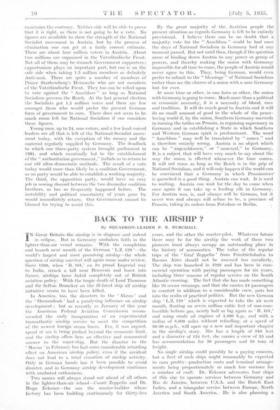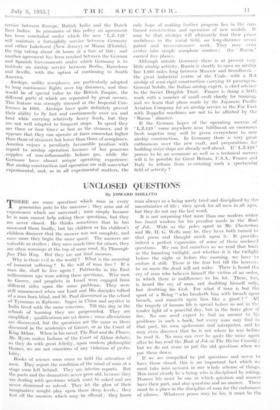BACK TO THE AIRSHIP ?
By SQUADRON-LEADER P. R. BURCHALL
IN Great Britairr.,the :airship is in disgrace .and indeed in eclipse. But in Germany unshaken faith in the lighter-than-air vessel remains. With the completion and launch next month of the German '129 '-the world's largest and most promising airship—the whore question of airship survival will again come under review. Sinee .1980, when R. 101,' on its proud Imperial way to India, struck a hill near Beauvars and burst into flames, airships have faded completely out of British aviation policy. With the tragic death of Lord Thomson and Sir Sefton Brancker on the ill-fated ship all' airship initiative seems to have been killed.
In America, too, the disasters to the Akron and the Shenandoah had a paralysing influence on airship development ; but as recently as January of this year the American Federal Aviation Commission recom- mended the early inauguration of an experimental transatlantic airship service to meet the competition of the newest foreign ocean liners. For, it was argued, speed at sea is being pushed beyond the economic limit, and the airship offers here an effective and economical answer to the super-ship'. But the disaster to the Macon in February has had some considerable retarding effect on American airship policy, even if the accident does not lead to a total' cessation of airship activity. Only in Gentian hands has it been possible to avoid disaster, and in Germany airship development continues with unabated enthusiasm.
Two names will always stand out ahead of all others in the lighter-than-air school—Count Zeppelin and Dr. Hugo Eckener—the one the master-builder Whose factory has been building continuously for thirty-five years, and the other the master-pilot. Whatever future there may be for the airship the work of these two pioneers must always occupy an outstanding place hi the histOry Of aeronautics: The value of the regular trips of the Graf Zeppelin'' from Friedrichshafen to Buenos Aires should not be assessed too' cavalierly. The ship was launched in 1928 and has been in (.0111- mercial operation with paying passengers for six years, including three seasons of regular service on the South Atlantic crossing. The fact that she has made something like 70 ocean crossings, and that she carries 24 passengers in comfort in addition to a considerable crew, puts her into the realm of practical polities. But the new German ship L.Z. 129 which is expected to take the air next month, floating on seven million cubic feet of non-com- bustible helium gas, nearly half as big again as R. 101,' and using crude oil engines of 4,400 h.p., and with a radius of 8,000 miles without refuelling, at a speed of 80-90 m.p.h., will open up a new and important chapter in the airship's story. She has a length of 810 feet and a diameter of 134 feet, she carries a crew of 85 and has accommodation for 50 passengers and 10 tons of freight.
No single airship could possibly be a paying concern, but a' fleet of such ships might reasonably be expected to earn profltS-L-production costs and terminal arrange- ments being proportionately so much less onerous for a number of craft. Dr. Eckener advocates four ships of this size to operate services between Germany and Rio de Janeiro, 'between U.S.A. and the Dutch East Indies, and a triangular. service between. Europe, North America and South America. :He is also planning a service between Europe; British India and the Dutch East Indies. In pursuance of this policy an agreement has been concluded under which the new L.Z. 129 ' will' maintain a fortnightly service• between Germany and either Lakehurst (NeW. Jersey) or Miami (Florida); the trip taking about 50 ' hours at a fare of £60 ; and another agreement has been reached between the German. and Spanish' Government§ under which .Germany is to. institute -fin airship service between Berlin, Barcelona and Seville, with the option of continuing to South America: . • Airships, unlike aeroplanes, are particularly adapted to long continuous flights over big distances, and thus would be of special Value to the British Empire, the different parts of which are separated by great oceans.' This feature was strongly stressed at the Imperial Con- ference in 1926. Airships have quite' definitely proved their , ability to fly fast and continuously over sea and land While carrying relatively heavy loads,. but they are not well adapted to frequent stops. In speed they are three or. four tunics as fast as• the steamer, and . it appears that they can operate at fares somewhat higher than those of steamers but lo-Wer than 'those of aeroplanes. America enjoys a peculiarly faVOUrable position with regard to airship operation because of her generous, supplies of non-inflammable helitint gas, while the Gerrnans have almost unique operating experience But airship construction and operation are still somewhat' experimental, and, as in all experimental matters, the only hope of making further progress lies in the con- tinued construction and operation of new models. It may be that airships will ultimately find their prime usefulness in the naval field, on long-distance ocean patrol and reconnaissance work. They may even evolve into simple aeroplane carriers' ; the Macon ' carried five planes.
Although outside Germany there is at present very little airship activity, Russia is shortly to open an airship line 1,000 miles long between Moscow and Sverdlovsk-- the great industrial centre of the Urals—with a B.6 airship of semi-rigid construction carrying 18 passengers.' General Nobile, the Italian airship expert, is chief advisor to the Soviet Dirigible Trust. France is doing a little work with a number of small craft chiefly for training, and We learn that plans made by the Japanese Pacific Aviation Company for an airship service in the Far East with Zeppelin machines are not to be affected • by the Macon ' disaster.
If the German hopes of the operating success of L.7.129 ' come anywhere near fulfilment an enormous. fresh impetus may well be given everywhere to new airship construction. In Germany there is very great enthusiasm over the new craft, and preparations for building sister ships are already well ahead. If ' L.Z.129: proves to be an economic as well as a technical success will it be possible for Great Britain; U.S.A., France and Italy to refrain from re-entering such 'a spectacular field of activity ?















































 Previous page
Previous page